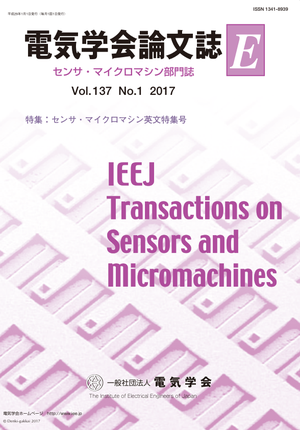Fabrication of a Cr Nanoporous Thin Film via Sputter Deposition and Investigation of Its Applicability as a Water-oil Separation Electrode in a MEMS Moisture Sensor
Fabrication of a Cr Nanoporous Thin Film via Sputter Deposition and Investigation of Its Applicability as a Water-oil Separation Electrode in a MEMS Moisture Sensor
カテゴリ: 論文誌(論文単位)
グループ名: 【E】センサ・マイクロマシン部門
発行日: 2017/01/01
タイトル(英語): Fabrication of a Cr Nanoporous Thin Film via Sputter Deposition and Investigation of Its Applicability as a Water-oil Separation Electrode in a MEMS Moisture Sensor
著者名: Yusuke Yoshii (Dept. of Micro-Nano Systems Engineering, Nagoya University), Yuuki Fukagawa (Dept. of Micro-Nano Systems Engineering, Nagoya University), Mizue Mizoshiri (Dept. of Micro-Nano Systems Engineering, Nagoya University), Junpei Sakurai (Dept. of
著者名(英語): Yusuke Yoshii (Dept. of Micro-Nano Systems Engineering, Nagoya University), Yuuki Fukagawa (Dept. of Micro-Nano Systems Engineering, Nagoya University), Mizue Mizoshiri (Dept. of Micro-Nano Systems Engineering, Nagoya University), Junpei Sakurai (Dept. of Micro-Nano Systems Engineering, Nagoya University), Seiichi Hata (Dept. of Micro-Nano Systems Engineering, Nagoya University)
キーワード: Moisture sensor,moisture-in-oil sensor,nanoporous thin film metal,chemical dealloying,combinatorial technique
要約(英語): A moisture-in-oil sensor, with a sandwich structure of Cr nanoporous thin film/polyimide film/Au electrode, was fabricated using a lithographic process, sputter deposition, and chemical dealloying. One of the Cr nanoporous thin films used as a molecular filter was made using oblique incidence film formation and sputter deposition at 2.5 Pa of argon and a 60 degree attaching angle. The fabricated Cr nanoporous thin film consisted of 30-50 nm pore sizes as a result of a “shadowing effect”. A moisture-in-oil sensor made with this Cr nanoporous thin film showed favorable responsiveness in oil, with a response time of about 7 minutes, well within the desired maximum value of 10 minutes. To further improve the responsiveness of the sensor, another Cr nanoporous thin film was prepared using a chemical dealloying process, which facilitates control of the pore sizes. This process consists of co-sputtering Cu and Cr, annealing for 1 h at 573 K and dealloying for 15 h in 32.5% HNO3. The thin film pore sizes depend on the initial Cu-Cr compositions, which were researched using a combinatorial technique at various fabrication conditions. We investigated a wide compositional range between 32 and 22 at.% Cr. It was found that between 28 and 22 at.% Cr, chemical dealloying results in low residual Cu, less than 10 at.%. The pore sizes obtained were <20 nm for 32 at.% Cr, 20-40 nm for 28 at.% Cr, 40-60 nm for 25 at.% Cr and >60 nm for 22 at.% Cr. The initial composition ratio of 28 at.% Cr was used to fabricate a Cr nanoporous electrode film filter for a moisture sensor. Unfortunately, the final residual Cu composition ratio was 17 at.%, which is more than the desired maximum of 10 at.%, because the thin film had a uniform composition. The changes in the electrostatic capacity of the moisture sensor as a function of relative humidity (50%RH-90%RH) in air were studied, and the sensor output followed changes in the relative humidity.
本誌: 電気学会論文誌E(センサ・マイクロマシン部門誌) Vol.137 No.1 (2017) 特集:センサ・マイクロマシン英文特集号
本誌掲載ページ: 15-22 p
原稿種別: 論文/英語
電子版へのリンク: https://www.jstage.jst.go.jp/article/ieejsmas/137/1/137_15/_article/-char/ja/
受取状況を読み込めませんでした


